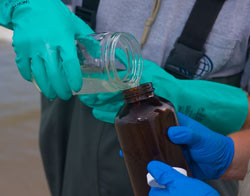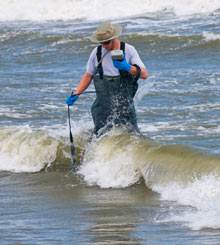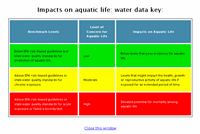EPA Response to BP Spill in the Gulf of Mexico
Coastal Water Sampling
In response to the BP oil spill, EPA monitored air, water, sediment, and waste generated by the cleanup operations. Ongoing response and restoration efforts are posted to RestoreTheGulf.gov.
While emergency response data collection has ended, results continue to be available on this site. Any new data will continue to be posted to this site, and data will continue to be available here for the foreseeable future.
Much of the content of this site continues to be available for historical and information purposes, but we are no longer updating these pages on a regular basis.
On this page:
You will need Adobe Reader to view some of the files on this page. See EPA's PDF page to learn more.
Understanding EPA's Water Data

Coastal water sample, Grand Isle, Louisiana.
- See the data
- We are aware that oil is present on some beaches and marshes along the coastline and are collecting samples in or close to these areas. It takes 7 to 10 days from the point of collection to analyze and post the data on the website so data posted may not reflect real-time conditions.
- EPA's water sampling process includes the collection of the sample, laboratory analyses and data verification (which ensures high quality data). These steps take about 7 to 10 days to complete before the data can be posted on EPA's website. As such, the data EPA posts is not representative of current conditions but rather is a snapshot in time for a given location. We continue to take water samples and will post data as soon as it becomes available.
- Water sampling locations are not necessarily representative of widespread coastal conditions.
- Visitors and residents should refer to state and local information for beach closure conditions in their area.
- EPA contaminant data are compared to technical benchmarks to determine the potential effects of contaminants on human health and aquatic life. Sample results are also being compared to EPA water quality criteria guidelines and State water quality standards, when available.
- In areas where contaminant levels exceed benchmarks, it is important to remember that historical contamination may exist in some sampling locations and may not be related to the BP spill.
- EPA, in partnership with states, oversees the National Coastal Condition Assessment (NCCA). NCCA reports describe the ecological and environmental conditions in U.S. coastal waters. When possible, EPA is comparing data collected during the BP spill response to the NCCA data.
- EPA sampling data is only one tool for examining water quality conditions. Again, we encourage visitors and residents interested in coastal, fishing and beach conditions to contact state and local authorities and websites.
Protect Yourself from Oil-Contaminated Water
EPA has started to sample waste and recovered oil along the shoreline. View more information about:
- recovered oil and waste along the Gulf coastline
- worker/volunteer health and safety (Unified Command site) | Related information from OSHA
- port conditions
Here are some simple steps you can take to protect yourself from contaminated water along the Gulf Coast:
- Pay attention to local authorities and avoid areas affected by the oil spill. The oil could cause health problems, including skin and eye irritation or breathing problems.
- Keep your pets from entering oil-contaminated areas.
- If you get contaminated water on your skin, wash it off immediately with soap and water or a hand cleanser meant to remove oils and grease.
- If you accidentally drink some oil-contaminated seawater and symptoms such as nausea, vomiting or dizziness occur, seek medical attention.
Water Data
Water Sampling Results - Assessing Impacts on Aquatic Life and Human Health
Water samples collected to assess potential oil spill impacts on aquatic life near shore were analyzed for 22 chemicals that are components of oil. To reach a level of concern in the table below, only one of the 22 chemicals would need to be present at an elevated level.
View aquatic life benchmark values by chemical
View human health benchmark values by chemical
Water Sampling Locations and Reports:
Location Analysis
Click here to view exceedance details (This will open in a new window)
Did the water exceed human health benchmarks?
YES: If a benchmark has been exceeded for a contaminant, it means that you should contact your state health agencies for additional information. State health agencies will provide information on what steps members of the public should take if they are exposed to these contaminants during activities on or around the coast. However, it is noteworthy that a benchmark assumes 90 hours of exposure to a chemical in question, so a single exposure is unlikely to result in significant risk.
Here are some simple steps you can take to protect yourself from contaminated water along the Gulf Coast:
- Pay attention to local authorities and avoid areas affected by the oil spill. The oil could cause health problems, including skin and eye irritation or breathing problems.
- Keep your pets from entering oil-contaminated areas.
- If you get contaminated water on your skin, wash it off immediately with soap and water or a hand cleanser meant to remove oils and grease.
- If you accidentally drink some oil-contaminated seawater and symptoms such as nausea, vomiting or dizziness occur, seek medical attention.
NO: Even when a human health benchmark has not been exceeded, residents and tourists should refer to state and local information for beach conditions in their area. EPA sampling data is only one tool for examining water quality conditions. In addition, it takes several days from the point of collection to analyze and post the data on the website so data posted may not reflect real-time conditions. If the water smells like gasoline or there are visible signs of oil contamination, swimming or contact with the water is not recommended.
Learn what the data mean to you
The color-coded table "Impacts on aquatic life" explains what the numbers on the table above mean to your health.
Analysis of water and sediment samples for dispersant-related compounds
See the methods and benchmarks for detecting dispersants in water samples
Download water and sediment analysis for dispersant-related compounds.
Samples taken at these locations were analyzed for dispersants:
- Sediment sample locations analyzed for dispersants May 15-August 9
- Water sample locations analyzed for dispersants May 17-August 18 *
* Analyses of surface water samples from August 6, 2010, for chemicals associated with dispersants revealed the presence of a dispersant-related chemical (specifically, bis (2-ethylhexyl) sodium sulfosuccinate) in one sample which was above the reporting limit but below the aquatic benchmark. Additional sampling and analysis conducted in this area on August 18 did not reveal dispersant chemicals above the reporting limit. The reporting limit is the level of a chemical that EPA's laboratory equipment can detect with accuracy.
Analysis of water samples for chemicals and compounds associated with oil
- Data reports are available on the water sampling locations shown on the interactive map on this page.
Oil Sample Results
EPA deployed field teams to collect a small number of samples of oily debris, tar balls, mousse oil and other petroleum waste products that have washed up on the shore or were present on the surface of the water along the Gulf Coast. Preliminary results have only shown chemical constituents that are usually found in petroleum products and therefore typical health precautions should be taken.
Samples were collected at multiple locations to determine the chemical makeup of the oil washing up on shorelines. Oil has been washing up in various physical forms and samples were taken accordingly of tarballs, weathered oil, oil mousse, and grease.
Mousse oil, tar balls and oily debris onshore are primarily physical hazards to plants, animals and people. Certain individuals may be sensitive to some of the compounds in oil, and exposure may be damaging to clothing and can be difficult to remove from skin.
For most individuals, occasional and brief contact with a small amount of oil, while not recommended, will do no harm. However, some people are especially sensitive to chemicals, including the hydrocarbons found in crude oil and petroleum products. They may have an allergic reaction or develop rashes even from brief contact. In general, we recommend that contact with oil be avoided. If contact occurs, wash the area with soap and water, baby oil, or a widely used, safe cleaning compound such as the cleaning paste sold at auto parts stores.
The public is reminded that oily debris should only be retrieved by trained personnel, if you would like to volunteer you need to become properly trained and equipped to help during the shoreline response efforts. For volunteer inquiries, visit Serve.gov and RestoreTheGulf.gov
- Data reports are available on the water sampling locations shown on the interactive map on this page.
Coastal Conditions in Your Area
For information on coastal conditions and beaches in your area please visit these state sites:
Alabama:
- Department of Environmental Management (ADEM) / Department of Public Health (ADPH) Coastal Beach Monitoring Program
- Office of Governor - Gulf of Mexico Oil Spill Information
Florida:
Louisiana:
Mississippi:
Texas:
Government Response
- RestoreTheGulf.gov: official federal government site for spill response and recovery
Other federal government information:
Connect with us:
Facebook: EPA
Twitter: EPA
Photos: BP Spill | more photos
Get email updates

Measuring temperature, PH and salinity near Grand Isle State Park, Grand Isle, Louisiana.

